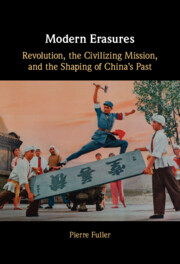Book contents
- Modern Erasures
- Modern Erasures
- Copyright page
- Dedication
- Contents
- Figures and Maps
- Acknowledgments
- Note on the Text
- Introduction
- Part I Seeing and Not Seeing
- Part II Revolutionary Memory in Republican China
- Part III Maoist Narratives in the Forties
- Part IV Politics of Oblivion in the People’s Republic
- Conclusion
- Glossary
- Bibliography
- Index
Conclusion
Published online by Cambridge University Press: 31 March 2022
- Modern Erasures
- Modern Erasures
- Copyright page
- Dedication
- Contents
- Figures and Maps
- Acknowledgments
- Note on the Text
- Introduction
- Part I Seeing and Not Seeing
- Part II Revolutionary Memory in Republican China
- Part III Maoist Narratives in the Forties
- Part IV Politics of Oblivion in the People’s Republic
- Conclusion
- Glossary
- Bibliography
- Index
Summary
The conclusion considers the implications of the epistemic destruction of the twentieth century for general narratives and scholarly works on modern Chinese history. It then turns to the continued role of wenshi ziliao as a form of communal memory, the role of disaster commemoration in the political legitimacy of the Chinese Communist Party, and the continued political relevance of revolutionary memory in the post-Mao People’s Republic of China.
Keywords
- Type
- Chapter
- Information
- Modern ErasuresRevolution, the Civilizing Mission, and the Shaping of China's Past, pp. 293 - 307Publisher: Cambridge University PressPrint publication year: 2022

